Related Research Articles
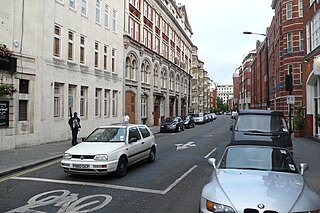
Drury Lane is a street on the eastern boundary of the Covent Garden area of London, running between Aldwych and High Holborn. The northern part is in the borough of Camden and the southern part in the City of Westminster. Drury Lane is part of London's West End Theatreland.

High Holborn is a street in Holborn and Farringdon Without, Central London, which forms a part of the A40 route from London to Fishguard. It starts in the west at the eastern end of St Giles High Street and runs past the Kingsway and Southampton Row, becoming Holborn at its eastern junction with Gray's Inn Road. The western stretch, as far as Drury Lane, was formerly known as Broad Street. On High Holborn, traffic flows one-way westbound from its junction with Drake Street to its western end, and flows both ways for the remainder.

The Theatre Royal, Drury Lane, commonly known as Drury Lane, is a West End theatre and Grade I listed building in Covent Garden, London, England. The building faces Catherine Street and backs onto Drury Lane. The building is the most recent in a line of four theatres which were built at the same location, the earliest of which dated back to 1663, making it the oldest theatre site in London still in use. According to the author Peter Thomson, for its first two centuries, Drury Lane could "reasonably have claimed to be London's leading theatre". For most of that time, it was one of a handful of patent theatres, granted monopoly rights to the production of "legitimate" drama in London.

Rutland House was the name of at least two London houses occupied by the Earls and Dukes of Rutland. That on Aldersgate Street was leased by playwright Sir William Davenant, who converted a room of it into a private theatre in the 1650s. That in Knightsbridge was a six-acre site until its demolition in the 1830s.

Long Acre is a street in the City of Westminster in central London. It runs from St Martin's Lane, at its western end, to Drury Lane in the east. The street was completed in the early 17th century and was once known for its coach-makers, and later for its car dealers.
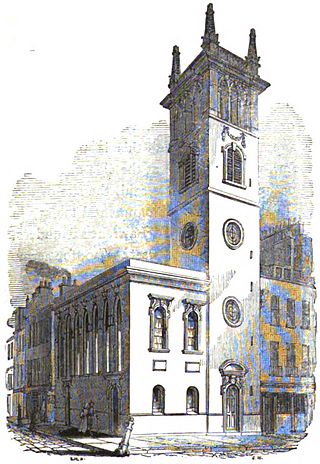
All Hallows Bread Street was a parish church in the Bread Street ward of the City of London, England. It stood on the east side of Bread Street, on the corner with Watling Street. First mentioned in the 13th century, the church was destroyed in the Great Fire of London in 1666. The church was rebuilt by the office of Sir Christopher Wren and demolished in 1876.

Wych Street was in London where King, Melbourne and Australia Houses now stand on Aldwych. It ran west from the church of St Clement Danes on the Strand to meet the southern end of Drury Lane. It was demolished by the London County Council in around 1901, as part of redevelopment bisected by new street Aldwych, the east of which mimics its course, in a curved way so taking up land buildings stood on, and these works created Kingsway.
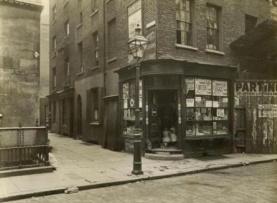
Clare Market is a historic area in central London located within the parish of St Clement Danes to the west of Lincoln's Inn Fields, between the Strand and Drury Lane, with Vere Street adjoining its western side. It was named after the food market which had been established in Clement's Inn Fields, by John Holles, 2nd Earl of Clare. Much of the area and its landmarks were immortalised by Charles Dickens in The Old Curiosity Shop, The Pickwick Papers, Barnaby Rudge and Sketches by Boz.
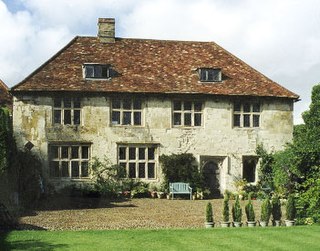
Hinxworth Place is a medieval manor house near Hinxworth, Hertfordshire, England.
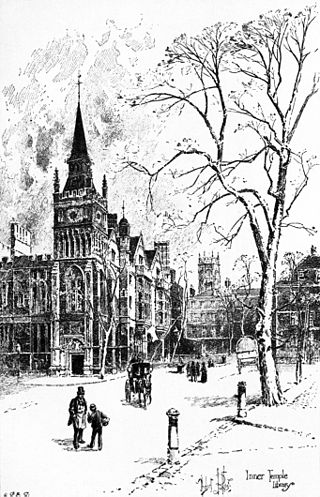
The Inner Temple Library is a private law library in London, England, serving barristers, judges, and students on the Bar Professional Training Course. Its parent body is the Honourable Society of the Inner Temple, one of the four Inns of Court.

Brown Hart Gardens, located off Duke Street, Mayfair, is a 10,000 square feet (929 m2) public garden on top of an electricity substation.
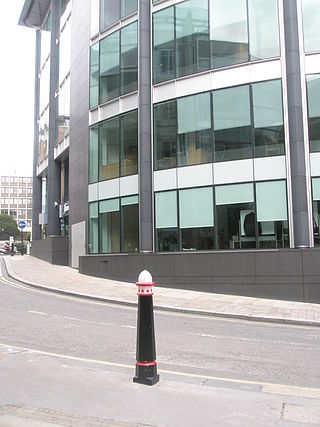
St Mary Mounthaw or Mounthaut was a parish church in Old Fish Street Hill in the City of London. Of medieval origin, it was destroyed in the Great Fire of London in 1666 and not rebuilt.

Locko Park is a privately owned 18th-century country house in between the villages of Stanley and Ockbrook in the borough of Erewash, near Spondon, Derbyshire, England. It is a Grade II* listed building.

Malvern House London was founded in 2000. It is an independent college and was accredited by the British Council in 2003. In July 2009 Malvern House merged with AEC Education Group PLC. Malvern House London is the only private college in the UK that is listed on the London Stock Exchange.
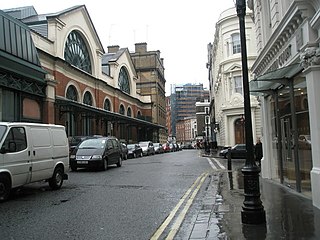
Tavistock Street is a street in the Covent Garden area of London which runs parallel to the Strand between Drury Lane and Southampton Street just south of the market piazza.

The Argyll Arms is a Grade II* listed public house at 18 Argyll Street, Soho, London, W1. It is located close to the site of the former Argyll House, the London residence of the Dukes of Argyll.

A statue of Sir Joshua Reynolds stands in the Annenberg Courtyard of Burlington House, off Piccadilly in the City of Westminster, London, England. Reynolds was the first president of the Royal Academy, who occupy the main wing of Burlington House.

The Baltic Exchange Memorial Glass comprises several stained glass windows designed by English artist John Dudley Forsyth which were installed over a staircase at the Baltic Exchange in London in 1922, as a memorial to the members of the exchange who were killed while serving during the First World War. The memorial glass was damaged in an IRA bombing in 1992. With funding from Swiss Re, the memorial glass was restored by glass conservators Goddard & Gibbs, and has been displayed at the National Maritime Museum in Greenwich since 2005.

Catherine Street, originally known as Brydges Street, is a street in the City of Westminster, London. It runs from Russell Street in the north to Aldwych in the south. It is crossed midway by Tavistock Street and joined on the western side near Aldwych by the eastern end of Exeter Street.
Kettner's Townhouse is a restaurant in London. Dating from 1867, it is one of the oldest restaurants in the city.
References
- 1 2 Wallis, John (1814). London: Being a Complete Guide to the British Capital. London: Sherwood, Neely, and Jones. pp. 139.
Coordinates: 51°30′47″N0°07′02″W / 51.5131°N 0.1173°W